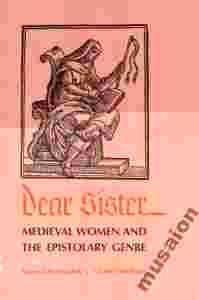DEAR SISTER
Medieval Women and the Epistolary Genre
Edited by Karen Cherewatuk and Ulrike Wiethans
Dear Sister: Medieval Women and the Epistolary Genre explores women's contributions to letter writing in Western Europe from the sixth to the sixteenth centuries. The essays represent the first attempt to chart medieval women's achievements in epistolarity, and the contributors to this volume situate the women writers in a solidly historical context and employ a variety of feminist approaches. Both religious and secular writers are discussed, including Radcgund, Hildegard of Bingen, Hcloi'se, Catherine of Siena, the women of the Paston family, Christine de Pizan, and Maria de Hout.
As the essays in this volume demonstrate, medieval women's epistles reflect a variety of purposes. In the high middle ages, cloistered women like Hildegard of Bingen used the epistolary form to merge spiritual direction with personal data. In her letters to Abelard, Heloise examines her conflicting roles of nun and abbess, wife and lover, and reveals the kind of deep self-analysis modern readers have come to expect from private letters. Margaret Paston's letters, concerned mostly with the management of households and estates, are devoid of the inner reflection we find in Hcloi'se's correspondence. If, in Virginia Woolfs words, there is "no writing for writing's sake" in the Paston family correspondence, it nonetheless reveals the ways in which a forceful woman such as Margaret Paston could dominate her own domestic sphere. Christine de Pizan, remarkable in her position as a professional woman of letters, writes to the c|tieen of France in an attempt to influence royal policy and pens epistles in an attempt to influence educational politics.
Karen Cherewatuk, Ulrike Wiethaus, and the contributors to Dear Sister also explore the relationship between formal models for letter writing and the innovative letters composed by women; they consider the implications of the ways in which letters circulated and letter collections were prepared; and they examine the relation between "public" and "private" spheres in medieval letters.
Dear Sister: Medieval Women and the Epistolary Genre is an important and unique source of information on medieval women's lives. It will be of interest to scholars and students of medieval literature, history, religion, and women's studies.
Contents
Acknowledgments. ix
Introduction: Women Writing Letters in the Middle Ages
Karen Cherewatuk & Ulrike Wiethaus 1
Radegund and Epistolary Tradition
Karen Cherewatuk 20
Visions and Rhetorical Strategy in the Letters of Hildegard of Bingen
Gillian T. W. Ahlgren 46
"Wholly Guilty, Wholly Innocent": Self-Definition in Heloise's Letters to Abelard
Glenda McLeod 64
"Io Catarina": Ecclesiastical Politics and Oral Culture in the Letters of Catherine of Siena
Karen Scott 87
"No Writing for Writing's Sake": The Language of Serviceand Household Rhetoric in the Letters of the Paston Women
Diane Watt 122
"Seulette a part"—The "Little Woman on the Sidelines" Takes Up Her Pen: The Letters of Christine de Pizan
Earl Jeffrey Richards 139
"If I Had an Iron Body": Femininity and Religion in the Letters of Maria de Hout
Ulrike Wiethaus 171
Bibliography 193
Index 207
Contributors 217

